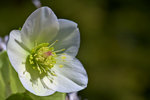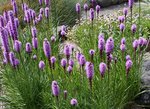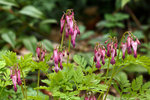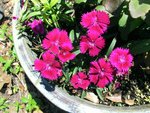




Many of us would love to have a yard full of beautiful flowering plants that bloom all season long, providing food for pollinators as well as visual interest. Lots of perennials have showy flowers in June and July, but often, in early spring and late summer, the yard looks a little bare despite our best efforts. Read on for some recommended plants that have a long flowering period and will help fill these gaps in your landscaping.
One of the earliest perennials to flower in Minnesota is the Christmas Rose, or Helleborus niger. In warmer climates it flowers around Christmas (hence the name) but in our growing zone, it will give you beautiful white flowers from March to May. It grows in upright clumps about 10-12” high and prefers a shady, moist area.
Dianthus and Fringed Bleeding Heart are two very long-blooming perennials that can fill gaps both early and later in the season. Both will start to flower around April and could continue until September, depending on the weather. Dianthus prefers sun or partial sun and is fairly short, growing 4-8” tall. It will put out even more flowers if you remove spent blooms throughout the season (also referred to as “deadheading”). There are lots of gorgeous Dianthus varieties – some of my favorites are Double Bubble (a double-layered, bubblegum-pink flower), American Pie Cherry (a cherry-red flower with silvery foliage) and Cranberry Cocktail (a carnation-like hot magenta flower).
Many of us grow Bleeding Heart in our yards, but Fringed Bleeding Heart (Dicentra eximia) is a slightly less common variety with a much longer blooming season (approximately April to September). Fringed Bleeding Heart is native to forests of the eastern United States and gets its name from its unique fern-like foliage. It prefers shade to partial shade and moist but well-draining soil. Its natural habitat is the forest floor, where lots of decaying plant debris enriches the soil – so add compost yearly to meet this plant’s nutrient needs.
There are several great options for garden color even later into the fall. Gayfeather, Threadleaf Coreopsis, and Russian Sage will bloom from about June to October. As a bonus, all of these are great for attracting butterflies and bees. Try placing them near your fruit or vegetable plants for improved pollination!
Gayfeather is also known as blazing star, or Liatris spicata. This plant grows to several feet tall and has spikes of strikingly bright purple flowers. It prefers a sunny spot with well-drained soil.
Threadleaf Coreopsis has delicate foliage and cheery yellow daisy-like flowers, and generally grows 18-20 inches tall. “Moonbeam” and “Zagreb” are two excellent varieties. Although we don’t often have to worry about deer in south Minneapolis, Threadleaf Coreopsis is also deer-resistant.
Russian Sage is a low-maintenance plant that has a beautiful fragrance and is sometimes used for aromatherapy. It prefers full sun but will tolerate dry conditions well. Russian Sage can grow 3-4 feet tall and has silvery foliage and delicate purple blossoms. When several plants are placed close together, it can make a beautiful fragrant hedge.
Finally, sedum is probably the latest-blooming perennial for our zone, often producing flowers until November. There are many different varieties of sedum, ranging from short, sprawling groundcovers to taller, bushy plants. You can find sedums that bloom in almost any color, to suit any landscape. Generally, though, they do well in full or part sun and don’t require much water. It’s also very easy to make more sedum plants to grow throughout your yard – just pinch off a stem from the main plant and stick it in the ground somewhere else. Keep it moist for a couple of weeks and it will begin to develop roots. Look for the “Autumn Joy” sedum variety for especially long-lived blooms that start out pink and become a lovely dark red in the fall.
As you can see, with a little advance planning, even those of us in northern climates can enjoy blooms all the way from spring until fall!
For more information on long-blooming perennials and many other types of plants, check out the publication “The Best Plants For 30 Tough Sites” from the University of Minnesota Extension. You can access it for free through the University of Minnesota Digital Conservancy, at conservancy.umn.edu.
Comments
No comments on this item Please log in to comment by clicking here